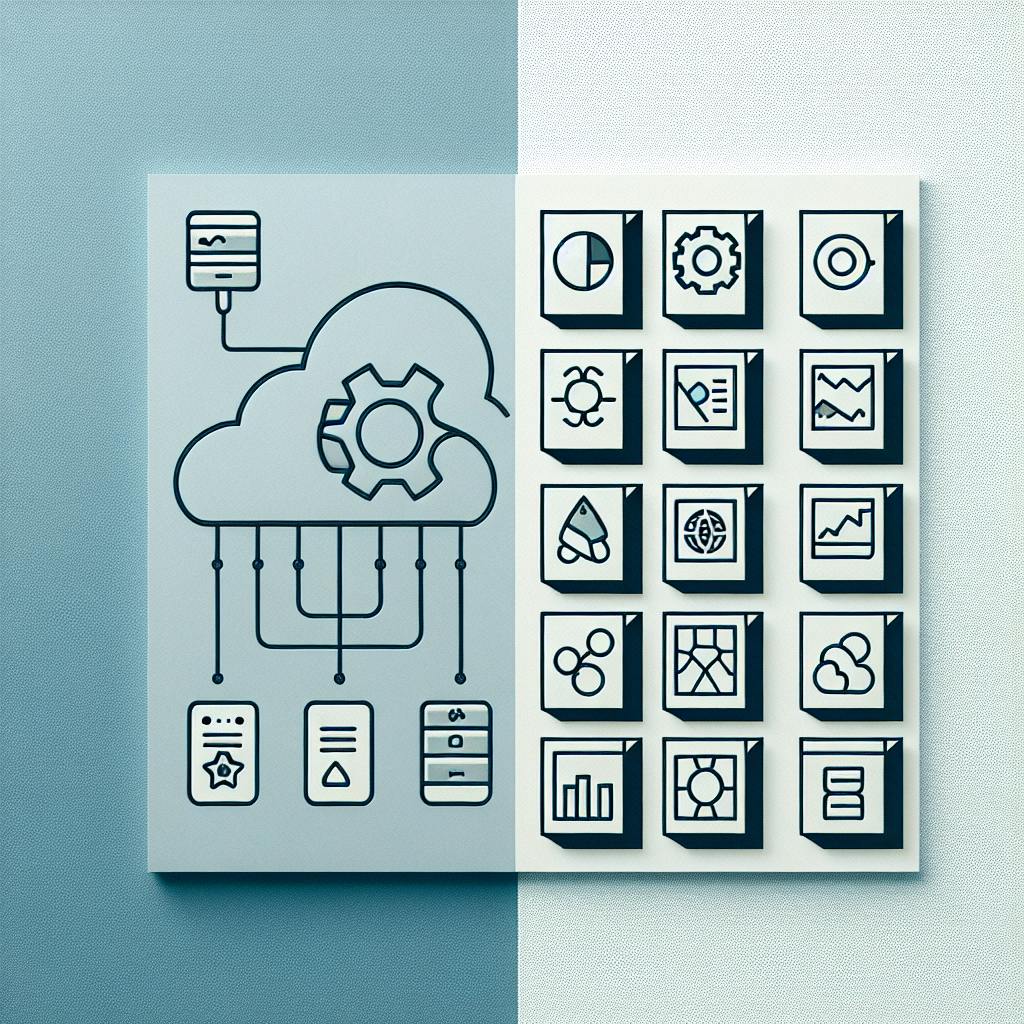This guide shows how to use Artificial Intelligence (AI) to automate IT compliance processes, making them faster, more accurate, and cost-effective. By implementing AI, organizations can:
- Automate Repetitive Tasks: AI handles routine compliance tasks like data entry, report generation, and monitoring, reducing human error.
- Identify Compliance Risks Early: AI analyzes large datasets to predict potential issues before they occur, allowing preventive action.
- Stay Aligned with Regulations: AI solutions automatically update policies and procedures as regulations evolve.
- Save Resources: Automating manual work frees up valuable staff time for strategic initiatives.
- Ensure Continuous Improvement: Organizations can regularly evaluate AI model performance, gather feedback, and refine models to maintain effectiveness.
To get started with AI for compliance automation:
- Identify Compliance Pain Points: Review current processes to pinpoint time-consuming, error-prone, or resource-intensive tasks.
- Choose Suitable AI Technologies: Select AI solutions like Machine Learning, Natural Language Processing, or Robotic Process Automation based on your needs.
- Prepare and Integrate Data: Gather data from various sources, clean it up, and connect AI to existing systems.
- Train and Test AI Models: Prepare training data, iteratively train and test models, and evaluate their performance.
- Put AI to Work: Integrate AI into workflows to automate key compliance activities like risk assessments and reporting.
- Monitor and Refine AI Performance: Set goals, regularly review performance, and refine models based on feedback.
- Use AI for Proactive Compliance: Leverage AI to forecast risks, simulate scenarios, and update policies proactively.
By following this guide, organizations can harness the power of AI to streamline compliance efforts, mitigate risks, and stay ahead of evolving regulations.
Related video from YouTube
Getting ready
Understand your current IT setup and compliance needs
Before using AI for IT compliance automation, take a close look at your existing IT systems, tools, and processes. Identify areas where AI could help streamline compliance tasks. This review will help you understand the resources needed and ensure your compliance requirements are met.
Ask yourself:
- What compliance tasks are time-consuming or error-prone?
- What IT systems and tools are currently in use?
- Are any automation processes already in place?
- What compliance regulations apply to your industry or region?
Answering these questions will give you a clear picture of your IT setup and compliance needs, helping you prepare for AI implementation.
Check data availability and quality
Data is crucial for training AI models. Evaluate the data sources you have, such as policies, regulations, and audit logs.
Consider:
- Is all necessary data available?
- Is the data accurate and up-to-date?
- Is the data consistent across different sources?
- Is the data free from errors and inconsistencies?
High-quality data is essential for accurate AI models. Poor data quality can lead to compliance risks and inefficiencies.
Get support and allocate resources
Implementing AI for IT compliance automation requires support from key stakeholders and resources.
Take these steps:
- Explain the benefits of AI implementation to stakeholders
- Identify resource needs, such as budget, personnel, and infrastructure
- Allocate resources effectively to support AI implementation
- Establish a project team to oversee the implementation and ensure stakeholder buy-in
Step 1: Identify compliance pain points
Review current compliance processes
First, look at how you currently handle compliance. This includes:
- The IT standards you follow (industry standards, internal rules, etc.)
- The types of sensitive data you store (personal info, health records, financial data, etc.)
Understanding your existing processes will show where AI can help streamline tasks and improve efficiency.
Find repetitive manual tasks
Next, identify tasks that are done manually over and over again, taking up a lot of time. Examples:
- Data entry
- Report generation
- Compliance monitoring
Automating these repetitive tasks with AI can reduce human error and free up resources.
Prioritize areas for automation
Focus on areas where automation would provide major benefits, such as:
- Risk assessment
- Report generation
Identify gaps in your current processes and prioritize areas where AI can bring the most value. This ensures resources are used effectively and AI improves compliance efficiency.
| Task | Description |
|---|---|
| Review current processes | Understand IT standards, data types, and existing compliance procedures |
| Identify repetitive tasks | Find manual, time-consuming tasks like data entry and report generation |
| Prioritize automation areas | Focus on high-impact areas like risk assessment and reporting |
Step 2: Choose suitable AI technologies
AI technologies for compliance automation
There are several AI technologies that can help automate compliance tasks:
- Machine Learning (ML): ML algorithms can analyze large datasets, identify patterns, and make predictions. This is useful for tasks like risk assessment and data monitoring.
- Natural Language Processing (NLP): NLP allows AI systems to understand human language. This helps analyze regulatory documents, contracts, and other compliance texts.
- Robotic Process Automation (RPA): RPA automates repetitive, rule-based tasks like data entry and report generation. This frees up compliance teams for higher-value work.
Selecting the right AI solution
When choosing an AI solution for compliance automation, consider these factors:
| Factor | Description |
|---|---|
| Integration | The AI solution should work with your existing IT systems and tools. |
| Scalability | The solution should be able to grow as your organization and compliance needs change. |
| Customization | The solution should be flexible enough to meet your specific compliance requirements. |
| Accuracy | Look for a solution with a high accuracy rate to minimize errors. |
| Reliability | The solution should maintain consistent performance over time. |
Step 3: Prepare and integrate data
Gather data from various sources
First, collect all the data needed for compliance automation. This includes:
- Documents (like policies and regulations)
- Spreadsheets
- Databases
- Other data sources
Make sure the data is current and correct.
Clean up the data
Next, clean and format the data to prepare it for AI processing:
- Remove duplicate entries
- Fix any missing information
- Put the data in a consistent format
High-quality data is key for AI to work properly.
Connect AI to existing systems
Finally, integrate the AI solution with your current IT systems and data storage. This allows:
- Seamless data flow between systems
- AI to access data from multiple places
- Automated compliance tasks and workflows
Integration frees up your compliance team to focus on higher-priority work.
| Task | Description |
|---|---|
| Gather data | Collect data from documents, spreadsheets, databases, and other sources |
| Clean data | Remove duplicates, fix missing data, format consistently |
| Integrate systems | Connect AI to IT systems and data storage for automated workflows |
sbb-itb-9890dba
Step 4: Train and Test AI Models
Prepare Training Data
To develop accurate AI models, you need to prepare labeled data sets for training. This step is crucial. The training data should:
- Be diverse and representative of real-world scenarios
- Be free from biases that could skew results
Having high-quality training data helps the AI models identify compliance patterns and make informed decisions.
Iterative Training and Testing
Use cycles of training and testing to refine the AI models:
- Feed the model new data
- Test its performance
- Make adjustments to improve accuracy
Continuous iteration allows you to:
- Identify potential errors
- Address issues
- Enhance the model's reliability and efficiency over time
Evaluate Model Performance
Regularly evaluate the AI models' performance and make necessary adjustments. Monitor key metrics like:
- Accuracy
- Precision
- Recall
| Task | Description |
|---|---|
| Prepare Training Data | Create labeled data sets to train AI models |
| Iterative Training and Testing | Refine models through cycles of training, testing, and adjustments |
| Evaluate Model Performance | Monitor metrics and make adjustments to improve accuracy |
By continuously evaluating and refining the models, you can ensure they remain effective in:
- Identifying compliance risks
- Finding opportunities for automation
Step 5: Put AI to Work for Compliance Tasks
Integrate AI into Existing Workflows
With your AI models trained and tested, it's time to put them to work. Incorporate the AI models into your current compliance processes to automate various tasks:
- Identify specific workflows that can benefit from AI automation
- Configure the AI models to work seamlessly with your existing systems and tools
- Set up clear data flows between the AI models and your workflows
Automate Key Compliance Activities
Once integrated, the AI models can automate crucial compliance tasks, such as:
- Continuous monitoring of compliance risks and controls
- Risk assessments and policy updates
- Audit preparation and reporting
- Compliance training programs
Automating these activities frees up your compliance team to focus on higher-value work like strategic planning and risk management.
Ensure Secure and Compliant AI Deployment
When deploying AI solutions, implement robust security and governance measures:
| Measure | Description |
|---|---|
| Access Controls | Restrict access to sensitive data with authentication mechanisms |
| Data Encryption | Encrypt data both in transit and at rest |
| Data Ownership | Establish clear data ownership and accountability |
| Incident Response | Develop plans for incident response and disaster recovery |
These measures ensure the secure and compliant use of AI solutions in your organization.
Step 6: Monitor and Refine AI Performance
Set Clear Goals
First, set clear goals for evaluating your AI models. These goals should align with your compliance needs. For example:
- Accuracy rate for compliance checks
- Time to identify and respond to risks
- Number of false positives or false negatives
- User satisfaction rates
Regularly Review Performance
Continuously monitor and review how your AI models perform. Look for areas to improve:
- Analyze performance data
- Update models as compliance rules change
- Get feedback from users
| Task | Details |
|---|---|
| Analyze Data | Review accuracy, response times, errors |
| Update Models | Retrain with new data as rules evolve |
| Get Feedback | Survey users on satisfaction and issues |
Refine Models Based on Feedback
Use the performance data and feedback to refine your AI models:
- Add new data sources to improve accuracy
- Adjust settings to better meet compliance goals
- Adopt new AI tech to stay ahead of emerging risks
| Refinement | Purpose |
|---|---|
| Add Data | Increase model accuracy |
| Adjust Settings | Align with compliance targets |
| New AI Tech | Address new and changing risks |
Step 7: Use AI for proactive compliance
Predict and prevent compliance risks
AI can analyze large data sets to identify patterns that may indicate potential compliance issues. This allows organizations to take action before problems occur, reducing the likelihood of costly violations or damage to their reputation.
For example, AI can:
- Forecast risks: Analyze data to predict areas at high risk for non-compliance, such as data privacy breaches or regulatory violations.
- Simulate scenarios: Model different situations to assess the potential impact of compliance breaches and develop response plans.
- Update policies: Automatically update compliance policies as regulations change, ensuring policies stay current.
| Task | Description |
|---|---|
| Forecast Risks | Identify high-risk areas for potential non-compliance |
| Simulate Scenarios | Model situations to assess breach impacts and plan responses |
| Update Policies | Automatically align policies with changing regulations |
Proactive compliance benefits
By using AI to proactively manage compliance, organizations can:
- Mitigate risks: Address potential issues before they escalate into costly violations.
- Stay compliant: Ensure policies and procedures align with the latest regulations.
- Save resources: Reduce time and effort spent on manual compliance tasks.
- Protect reputation: Avoid public incidents that could damage the organization's image.
Proactive compliance powered by AI helps organizations stay ahead of evolving regulations and protect against compliance failures. It enables a strategic, preventative approach to compliance management.
Summary
AI Compliance Automation Benefits
AI-driven compliance automation offers many advantages that simplify processes, boost accuracy, and cut costs:
- Automated Tasks: AI handles routine compliance tasks, reducing human error and ensuring consistent regulation adherence.
- Freed Resources: Automating manual work frees up valuable staff time for strategic initiatives.
- Risk Identification: AI's data analysis capabilities identify potential compliance risks early, allowing preventive action.
- Real-Time Monitoring: AI continuously monitors operations and transactions, instantly flagging potential breaches.
- Regulatory Alignment: AI solutions keep compliance efforts aligned with evolving regulations.
Continuous Improvement Approach
As regulations and business environments change, organizations must continuously improve their compliance processes:
| Task | Description |
|---|---|
| Evaluate Performance | Regularly review AI model performance metrics |
| Gather Feedback | Collect input from stakeholders on issues and satisfaction |
| Refine Models | Update AI models with new data and adjust settings as needed |
| Adopt New Tech | Implement new AI technologies to address emerging risks |
This iterative approach ensures compliance efforts remain effective and up-to-date.
Adopting AI Solutions
To fully leverage AI-driven compliance automation, organizations should:
- Explore AI solutions tailored to their specific compliance needs
- Partner with AI vendors or develop custom AI models
- Invest in staff training on AI implementation and use



